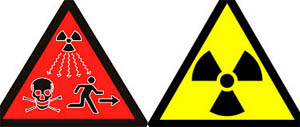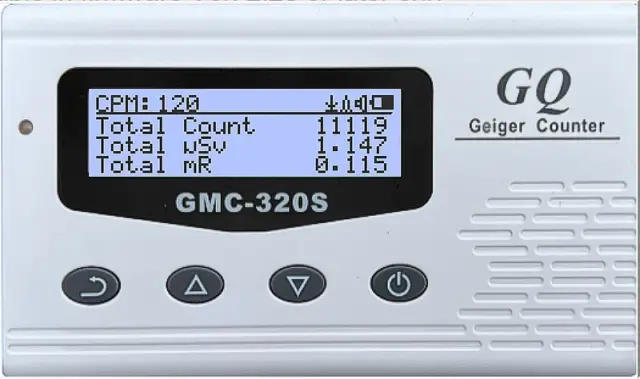Geiger Counter Readings – How Bad is Bad?

The following information may help you understand Geiger Counter Readings, the units of measurement for Geiger Counters (nuclear radiation detectors).
Radiation Units of Measurement
1 rad = 0.01 gray (Gy)
1 gray (Gy) = 100 rad
1 rem = 0.01 sievert (Sv)
1 sievert (Sv) = 100 rem
Rad and Gray are ‘absorbed dose’ units.
Rem and Sievert are ‘equivalent dose’ units.
Rem and Sievert
The units of ‘rem’ and ‘sievert’ relate to biological damage done to human tissue.
These units factor the differences between types of radiation. A multiplication factor (radiation factor) is used that represents the ‘effective’ biological damage of a given type of radiation. This is the main reason for these units – to factor the differences in damage that is caused from one type of radiation to the next.
Radiation Factor (QF Quality Factor)
(1) Beta
(1) Gamma
(1) X-ray
(10) Nuetron
(20) Alpha
For example, the list above shows that a ‘rad’ or ‘gray’ unit of ‘Alpha’ energy that is absorbed by soft human tissue does 20 times more damage than a ‘rad’ or ‘gray’ of Gamma, X-ray or Beta radiation.
Protect your Thyroid:

iOSAT Potassium Iodide Tablets
(view on amzn)
Radiation Dosage
Radiation dosage is a measure of risk – the biological harm that tissues receive in the body.
The unit of absorbed radiation dose is the sievert (Sv). Since one sievert is a large quantity, radiation doses are normally expressed in smaller units, milliSievert (mSv) or microSievert (µSv) which are one-thousandth or one-millionth of a sievert.
For example, one chest X-ray will result in about 0.2 milliSievert (mSv) of radiation dose.
On average, our annual radiation exposure from all natural sources is about 300 milliRem, which is equivalent to 3 milliSieverts (3 mSv). Adding man-made sources (medical procedures, and others) the average annual U.S. radiation dose is about 600 milliRem, which is equivalent to 6 milliSieverts (6 mSv).
Average annual human exposure to radiation (U.S.)
600 milliRem (mRem)
6 milliSievert (mSv)
Radiation dose for increase cancer risk of 1 in a 1,000
1,250 milliRem (mRem)
12.5 milliSievert (mSv)
Earliest onset of radiation sickness
75,000 milliRem (mRem)
750 milliSievert (mSv)
Onset of radiation poisoning
300,000 milliRem (mRem)
3,000 milliSievert (mSv)
Expected 50% death from radiation
400,000 milliRem (mRem)
4,000 milliSievert (mSv)
GMC-300S Geiger counter, Radiation Detector, Dosimeter
(GQ Electronics on amzn)

NOTE: I will soon be updating the following sections regarding CPM, because it is a unit dependent upon the type of Geiger tube that’s in any given radiation detector. I intend to include (convert to) uSv/hr as well as accumulated dose (uSv) in order to present a normalized set of numbers.
Measuring Radiation with a Geiger Counter (CPM)
Geiger Counter Readings: What are CPM units?
CPM abbreviates Counts Per Minute and is a measure of radioactivity – a unit of measurement seen on some Geiger counters. Technically, “It is the number of atoms in a given quantity of radioactive material that are detected to have decayed in one minute.”
Most Geiger counters are calibrated to Cs137 (Cesium), a radioactive isotope.
1,200 CPM on the meter (for Cs137) is about 1 mR/hr (milliRad per hour).
120 CPM on the meter (for Cs137) is about 1 uSv/hr (microSievert per hour).
How Much CPM is Dangerous?
When does the CPM count become bad?
That depends on how long you are exposed at any given level. It is a function over time. The level itself, and how long.
The Radiation Network website, for example, uses a threshold warning level of 100 CPM for 3 consecutive minutes before sending out an alert. They say “it would be unusual for those levels to exceed 100 CPM”.
So, how do we correlate CPM numbers with dangerous?
First, we must understand a few radiation facts and numbers regarding dosage. By plodding through the math, we can determine a relationship of Geiger counter numbers versus the risks to your health.
What do the Geiger Counter Readings mean as related to health risk?
For example, the CPM readings that you might see on the Radiation Network Map or elsewhere.
With the radiation dose examples listed above, we can correlate how long it would take to experience those effects based on hypothetical Geiger counter readings given in CPM.
So, let’s use the number 100, since this is the threshold that the Radiation Network website has chosen. The Cs137 calibration factor listed above (120 CPM) was converted to obtain the proper factored results listed below (0.83x). Higher CPM readings are also listed for relevancy.
Days compared with the average annual human exposure (U.S.)
207 (at 100 CPM)
42 (at 500 CPM)
14 (at 1,500 CPM)
2 (at 10,000 CPM)
Days to receive chronic dose for increase cancer risk of 1 in a 1,000
432 (at 100 CPM)
86 (at 500 CPM)
28 (at 1,500 CPM)
4 (at 10,000 CPM)
Days for earliest onset of radiation sickness
25,937 (at 100 CPM)
5,187 (at 500 CPM)
1,729 (at 1,500 CPM)
259 (at 10,000 CPM)
Caution regarding CPM readings:
CPM readings are not necessarily consistent from one device to another.
The Geiger-Mueller tube within the Geiger counter come in all shapes and sizes. Some are incredibly sensitive. Others are not. Some are high quality. Others are not.
The tube on a quality Geiger counter will typically be several times larger than the tube on a cheaper Geiger counter (for example). So comparatively it will always pick up a larger CPM value.
It’s possible for one device to have a reading of 150 CPM while another device only reads 50 CPM. Therefore in a given area it’s best to know the normal background radiation level from your specific device.
Conclusion: The Geiger Counter readings that one may experience can be compared to the equivalent ‘what-IF’ scenarios listed above for potential health impact. The lower the better. There are lots of theories and opinions regarding long-term effects, dosage vs. health, acute vs. chronic, and the effects of various types of radioactive ionized particles making it into the food chain, etc… Do your due-diligence
Interesting fact:
All food sources combined, expose a person to around 40 millirems per year on average.
Many foods are naturally radioactive, and bananas are particularly so, due to the radioactive potassium-40 they contain. The equivalent dose for 365 bananas (one per day for a year) is 3.6 millirems (36 μSv).
Other foods that have above-average levels are potatoes, kidney beans, nuts (especially brazil nuts), and sunflower seeds.
Ways to limit radiation exposure:
1. Time (limit exposure time)
2. Distance (intensity decreases sharply according to the inverse-square-law)
3. Shielding
(alpha: nearly anything… a sheet of paper will stop it – danger of breathing it)
(beta: wood, water, plastic-acrylic, aluminum)
(gamma: water, concrete, lead)
Disclaimer: The information in this article is one person’s estimation based on several hours research and working through some math.
[ Read: Best Geiger Counter For Preparedness ]
[ Read: Best Gas Mask For Nuclear Fallout ]
